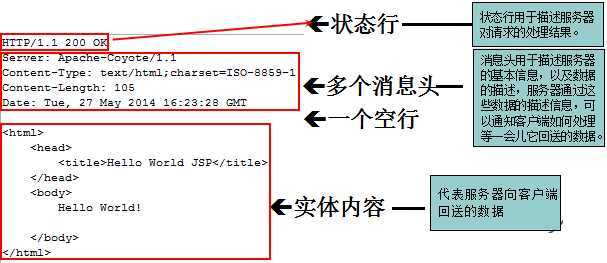标签:des cWeb style blog http io color os ar
转载自http://www.cnblogs.com/xdp-gacl/p/3751277.html感谢孤傲苍狼的分享。
HTTP是hypertext transfer protocol(超文本传输协议)的简写,它是TCP/IP协议的一个应用层协议,用于定义WEB浏览器与WEB服务器之间交换数据的过程。客户端连上 web服务器后,若想获得web服务器中的某个web资源,需遵守一定的通讯格式,HTTP协议用于定义客户端与web服务器通迅的格式。
HTTP协议的版本:HTTP/1.0、HTTP/1.1
在HTTP1.0协议中,客户端与web服务器建立连接后,只能获得一个web资源。
在HTTP1.1协议,允许客户端与web服务器建立连接后,在一个连接上获取多个web资源。
客户端连上服务器后,向服务器请求某个web资源,称之为客户端向服务器发送了一个HTTP请求。
一个完整的HTTP请求包括如下内容:一个请求行、若干消息头、以及实体内容
范例:

请求行中的GET称之为请求方式,请求方式有:POST、GET、HEAD、OPTIONS、DELETE、TRACE、PUT,常用的有: GET、 POST
用户如果没有设置,默认情况下浏览器向服务器发送的都是get请求,例如在浏览器直接输地址访问,点超链接访问等都是get,用户如想把请求方式改为post,可通过更改表单的提交方式实现。
不管POST或GET,都用于向服务器请求某个WEB资源,这两种方式的区别主要表现在数据传递上:如果请求方式为GET方式,则可以在请求的URL地
址后以?的形式带上交给服务器的数据,多个数据之间以&进行分隔,例如:GET
/mail/1.html?name=abc&password=xyz HTTP/1.1
GET方式的特点:在URL地址后附带的参数是有限制的,其数据容量通常不能超过1K。
如果请求方式为POST方式,则可以在请求的实体内容中向服务器发送数据,Post方式的特点:传送的数据量无限制。
HTTP请求中的常用消息头
accept:浏览器通过这个头告诉服务器,它所支持的数据类型
Accept-Charset: 浏览器通过这个头告诉服务器,它支持哪种字符集
Accept-Encoding:浏览器通过这个头告诉服务器,支持的压缩格式
Accept-Language:浏览器通过这个头告诉服务器,它的语言环境
Host:浏览器通过这个头告诉服务器,想访问哪台主机
If-Modified-Since: 浏览器通过这个头告诉服务器,缓存数据的时间
Referer:浏览器通过这个头告诉服务器,客户机是哪个页面来的 防盗链
Connection:浏览器通过这个头告诉服务器,请求完后是断开链接还是何持链接
例如:
1 Accept: application/x-ms-application, image/jpeg, application/xaml+xml, image/gif, image/pjpeg,
2 application/x-ms-xbap, application/vnd.ms-excel, application/vnd.ms-powerpoint, application/msword, */*
3 Referer: http://localhost:8080/JavaWebDemoProject/Web/2.jsp
4 Accept-Language: zh-CN
5 User-Agent: Mozilla/4.0 (compatible; MSIE 8.0; Windows NT 6.1; WOW64; Trident/4.0; SLCC2; .NET CLR 2.0.50727; .NET CLR 3.5.30729; .NET CLR 3.0.30729; Media Center PC 6.0; .NET4.0C; .NET4.0E; InfoPath.3)
6 Accept-Encoding: gzip, deflate
7 Host: localhost:8080
8 Connection: Keep-Alive
一个HTTP响应代表服务器向客户端回送的数据,它包括: 一个状态行、若干消息头、以及实体内容 。

范例:
1 HTTP/1.1 200 OK
2 Server: Apache-Coyote/1.1
3 Content-Type: text/html;charset=ISO-8859-1
4 Content-Length: 105
5 Date: Tue, 27 May 2014 16:23:28 GMT
6
7 <html>
8 <head>
9 <title>Hello World JSP</title>
10 </head>
11 <body>
12 Hello World!
13
14 </body>
15 </html>
状态行格式: HTTP版本号 状态码 原因叙述<CRLF>
举例:HTTP/1.1 200 OK
状态码用于表示服务器对请求的处理结果,它是一个三位的十进制数。响应状态码分为5类,如下所示:
HTTP响应中的常用响应头(消息头)
Location: 服务器通过这个头,来告诉浏览器跳到哪里
Server:服务器通过这个头,告诉浏览器服务器的型号
Content-Encoding:服务器通过这个头,告诉浏览器,数据的压缩格式
Content-Length: 服务器通过这个头,告诉浏览器回送数据的长度
Content-Language: 服务器通过这个头,告诉浏览器语言环境
Content-Type:服务器通过这个头,告诉浏览器回送数据的类型
Refresh:服务器通过这个头,告诉浏览器定时刷新
Content-Disposition: 服务器通过这个头,告诉浏览器以下载方式打数据
Transfer-Encoding:服务器通过这个头,告诉浏览器数据是以分块方式回送的
Expires: -1 控制浏览器不要缓存
Cache-Control: no-cache
Pragma: no-cache
1 package gacl.http.study;
2 import java.io.IOException;
3 import javax.servlet.ServletException;
4 import javax.servlet.http.HttpServlet;
5 import javax.servlet.http.HttpServletRequest;
6 import javax.servlet.http.HttpServletResponse;
7 /**
8 * @author gacl
9 *
10 */
11 public class ServletDemo01 extends HttpServlet {
12 public void doGet(HttpServletRequest request, HttpServletResponse response)
13 throws ServletException, IOException {
14
15 response.setStatus(302);//设置服务器的响应状态码
16 /**
17 *设置响应头,服务器通过 Location这个头,来告诉浏览器跳到哪里,这就是所谓的请求重定向
18 */
19 response.setHeader("Location", "/JavaWeb_HttpProtocol_Study_20140528/1.jsp");
20 }
21 public void doPost(HttpServletRequest request, HttpServletResponse response)
22 throws ServletException, IOException {
23 this.doGet(request, response);
24 }
25 }
当在浏览器中使用URL地址"http://localhost:8080 /JavaWeb_HttpProtocol_Study_20140528/servlet/ServletDemo01"访问 ServletDemo01时,就可以看到服务器作出响应后发送到浏览器的状态码和响应头信息,如下图所示:
服务器返回一个302状态码告诉浏览器,你要的资源我没有,但是我通过Location响应头告诉你哪里有,而浏览器解析响应头 Location后知道要跳转到/JavaWeb_HttpProtocol_Study_20140528/1.jsp页面,所以就会自动跳转到 1.jsp,如下图所示:
1 package gacl.http.study;
2
3 import java.io.ByteArrayOutputStream;
4 import java.io.IOException;
5 import java.util.zip.GZIPOutputStream;
6 import javax.servlet.ServletException;
7 import javax.servlet.http.HttpServlet;
8 import javax.servlet.http.HttpServletRequest;
9 import javax.servlet.http.HttpServletResponse;
10 /**
11 * @author gacl
12 *这个小程序是用来演示以下两个小知识点
13 *1、使用GZIPOutputStream流来压缩数据
14 *2、设置响应头Content-Encoding来告诉浏览器,服务器发送回来的数据压缩后的格式
15 */
16 public class ServletDemo02 extends HttpServlet {
17
18 public void doGet(HttpServletRequest request, HttpServletResponse response)
19 throws ServletException, IOException {
20 String data = "abcdabcdabcdabcdabcdabcdab" +
21 "cdabcdabcdabcdabcdabcdabcdabcdabc" +
22 "dabcdabcdabcdabcdabcdabcdabcdabc" +
23 "dabcdabcdabcdabcdabcdabcdabcdabcdab" +
24 "cdabcdabcdabcdabcdabcdabcdabcdabcdab" +
25 "cdabcdabcdabcdabcdabcdabcdabcdabcdab" +
26 "cdabcdabcdabcdabcdabcdabcdabcdabcdab" +
27 "cdabcdabcdabcdabcdabcdabcdabcdabcdabcd";
28 System.out.println("原始数据的大小为:" + data.getBytes().length);
29
30 ByteArrayOutputStream bout = new ByteArrayOutputStream();
31 GZIPOutputStream gout = new GZIPOutputStream(bout); //buffer
32 gout.write(data.getBytes());
33 gout.close();
34 //得到压缩后的数据
35 byte g[] = bout.toByteArray();
36 response.setHeader("Content-Encoding", "gzip");
37 response.setHeader("Content-Length",g.length +"");
38 response.getOutputStream().write(g);
39 }
40
41 public void doPost(HttpServletRequest request, HttpServletResponse response)
42 throws ServletException, IOException {
43 this.doGet(request, response);
44 }
45 }
服务器发给浏览器的响应信息如下:
浏览器支持的压缩格式有:
1 package gacl.http.study;
2 import java.io.IOException;
3 import java.io.InputStream;
4 import java.io.OutputStream;
5 import javax.servlet.ServletException;
6 import javax.servlet.http.HttpServlet;
7 import javax.servlet.http.HttpServletRequest;
8 import javax.servlet.http.HttpServletResponse;
9 public class ServletDemo03 extends HttpServlet {
10 public void doGet(HttpServletRequest request, HttpServletResponse response)
11 throws ServletException, IOException {
12 /**
13 * 浏览器能接收(Accept)的数据类型有:
14 * application/x-ms-application,
15 * image/jpeg,
16 * application/xaml+xml,
17 * image/gif,
18 * image/pjpeg,
19 * application/x-ms-xbap,
20 * application/vnd.ms-excel,
21 * application/vnd.ms-powerpoint,
22 * application/msword,
23 */
24 response.setHeader("content-type", "image/jpeg");//使用content-type响应头指定发送给浏览器的数据类型为"image/jpeg"
25 //读取位于项目根目录下的img文件夹里面的WP_20131005_002.jpg这张图片,返回一个输入流
26 InputStream in = this.getServletContext().getResourceAsStream("/img/WP_20131005_002.jpg");
27 byte buffer[] = new byte[1024];
28 int len = 0;
29 OutputStream out = response.getOutputStream();//得到输出流
30 while ((len = in.read(buffer)) > 0) {//读取输入流(in)里面的内容存储到缓冲区(buffer)
31 out.write(buffer, 0, len);//将缓冲区里面的内容输出到浏览器
32 }
33 }
34 public void doPost(HttpServletRequest request, HttpServletResponse response)
35 throws ServletException, IOException {
36 this.doGet(request, response);
37 }
38 }
服务器发给浏览器的响应信息如下:
ServletDemo03的运行结果如下图所示:
在浏览器中显示出了图片
1 package gacl.http.study;
2
3 import java.io.IOException;
4 import javax.servlet.ServletException;
5 import javax.servlet.http.HttpServlet;
6 import javax.servlet.http.HttpServletRequest;
7 import javax.servlet.http.HttpServletResponse;
8
9 public class ServletDemo04 extends HttpServlet {
10 public void doGet(HttpServletRequest request, HttpServletResponse response)
11 throws ServletException, IOException {
12 /**
13 * 设置refresh响应头,让浏览器每隔3秒定时刷新
14 */
15 // response.setHeader("refresh", "3");
16 /**
17 * 设置refresh响应头,让浏览器3秒后跳转到http://www.baidu.com
18 */
19 response.setHeader("refresh", "3;url=‘http://www.baidu.com‘");
20 response.getWriter().write("gacl");
21 }
22
23 public void doPost(HttpServletRequest request, HttpServletResponse response)
24 throws ServletException, IOException {
25 this.doGet(request, response);
26 }
27
28 }
1 package gacl.http.study;
2
3 import java.io.IOException;
4 import java.io.InputStream;
5 import java.io.OutputStream;
6
7 import javax.servlet.ServletException;
8 import javax.servlet.http.HttpServlet;
9 import javax.servlet.http.HttpServletRequest;
10 import javax.servlet.http.HttpServletResponse;
11
12 public class ServletDemo05 extends HttpServlet {
13 public void doGet(HttpServletRequest request, HttpServletResponse response)
14 throws ServletException, IOException {
15 /**
16 * 设置content-disposition响应头,让浏览器下载文件
17 */
18 response.setHeader("content-disposition", "attachment;filename=xxx.jpg");
19 InputStream in = this.getServletContext().getResourceAsStream("/img/1.jpg");
20 byte buffer[] = new byte[1024];
21 int len = 0;
22 OutputStream out = response.getOutputStream();
23 while ((len = in.read(buffer)) > 0) {
24 out.write(buffer, 0, len);
25 }
26 }
27
28 public void doPost(HttpServletRequest request, HttpServletResponse response)
29 throws ServletException, IOException {
30 this.doGet(request, response);
31 }
32
33 }
在浏览器中访问ServletDemo05就会弹出文件下载框,如下图所示:
标签:des cWeb style blog http io color os ar
原文地址:http://www.cnblogs.com/zhjjla/p/4060152.html